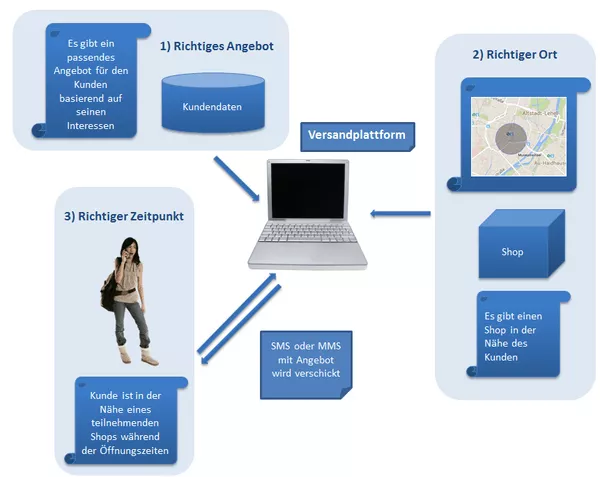Starting Situation
The modern market is overcrowded by a variety of providers of goods and services. Many of them try to reach the customer not only via traditional ways, such as e.g. billboards in the streets or shop windows, but also online. One type of online marketing is location based advertising (LBA) which is sent to the customers' mobile terminals. In this context, it is decisive that the dispatch is aligned with the customers' location. Thus, the customer receives an offer at the time he/she is in the vicinity of a promotion location. The rule for location based advertising is: "Right offer, right location, right time".
Approach
Outlining the idea is easy: the customer passes a participating shop and receives a text message or MMS advertising an offer which is of interest to the customer and which is ongoing in the vicinity. In order to enable this, the customer's data is processed with his/her position and the location of the shop and the offers are sent. The whole process is illustrated below:

1) Right Offer
Prerequisite for the introduction of location based advertising is a well-structured and complete DWH. The customer data available in the DWH is analyzed and the customers' possible interests are deduced. The more you know about the customer, the better and more precisely you can form target groups and meet the interests. For the segmentation, both general properties such as e.g. age, gender or net household income, and more specific properties of the customer, for example whether a customer has been interested in similar products, are used. A target group formed in this way is then contacted via location based advertising. The response, i.e. the reaction to the offers (clicking the link, buying the product etc.), is integrated into the DWH and the customer data is thus continually expanded.
2) Right Location
The second important component of location based advertising is the placing. The customer should be addressed when he/she is in the vicinity of an offer. For this purpose, the geo-coordinates, i.e. longitude and latitude, are required. Each offer is assigned to a location on the map, e.g. a shop or a promotion location. The exact coordinates are determined and the shops are placed on Google Maps. By entering a radius, one can control the extent of the surrounding area in which customers should be addressed. Thus, geo-zones are formed. This information is later compared to the customers' current location and the dispatch of a message is triggered.
3) Right Time
If the customer generates an event within a geo-zone, e.g. sends a text message, receives a call or enters a geo-zone, his/her location is identified and it is verified whether there is a suitable offer for him/her nearby. Depending on opening hours, duration of the special offer or other guidelines, time windows can be defined within which a dispatch is possible. Thus, there may be dispatches e.g. only on Mondays from 9 am to 12 pm, or there will be no dispatches on certain holidays. This ensures that the customer only receives an offer if he/she is able to redeem it immediately.
Interaction of Factors
In order to contact the customers with the right offer, new target groups are formed every night. For this purpose, a recalculation of the customer base is made on the basis of particular customer properties and interests, of course, taking into account the consent to the geo-based contacting. The selected customer data is forwarded to the transmission platform. There, all campaign-related information is compiled,then the text messages and MMS are sent.
The geo-coordinates of individual shops and promotion locations are directly uploaded to the transmission platform. In addition, there is the information on the customer's location from the network. The location of a cell which the customer's mobile phone connects with is compared to the location of the participating shops. It is analyzed whether there is a suitable offer for the customer in the vicinity. In this case, an offer is dispatched. It is possible to personalize the text per shop by inserting an exact address into the text message. In this case, the customer immediately knows where to go in order to redeem the offer. In addition, there is the possibility to control the dispatch volume by defining certain rules, so that e.g. no more than one text message per customer and day, no more than 2text messages on one topic per week or no more than 5 text messages per month are sent. This prevents the customer from being contacted too often. Such restrictions counteract the customer's de-registration from the location based advertising which might be made due to an overly high contact number.
Summary
Location based advertising makes it possible to address the customer with the suitable offer in the right location at the right time. The likelihood that the customer redeems the offer is increased by addressing him/her at the time at which he/she is in the vicinity of a relevant shop. The dispatch information and the customer reaction are returned by the transmission platform and integrated into the DWH. By means of such a closed loop approach, the target groups can be formed with even more precision and detail. It is important to consider that the customer is not contacted with similar offers too frequently and thus unsubscribes from the service. Location based advertising is designed to dispatch a suitable offer to the customer in time and thus increase likelihood of redemption and customer satisfaction.







